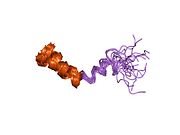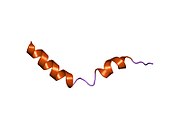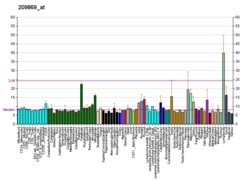Alpha-2A adrenergic receptor
| ADRA2A | |||||||||||||||||||||||||||||||||||||||||||||||||||
|---|---|---|---|---|---|---|---|---|---|---|---|---|---|---|---|---|---|---|---|---|---|---|---|---|---|---|---|---|---|---|---|---|---|---|---|---|---|---|---|---|---|---|---|---|---|---|---|---|---|---|---|
 | |||||||||||||||||||||||||||||||||||||||||||||||||||
| |||||||||||||||||||||||||||||||||||||||||||||||||||
| Identifiers | |||||||||||||||||||||||||||||||||||||||||||||||||||
| Aliases | ADRA2A, ADRA2, ADRA2R, ADRAR, ALPHA2AAR, ZNF32, adrenoceptor alpha 2A | ||||||||||||||||||||||||||||||||||||||||||||||||||
| External IDs | OMIM: 104210 MGI: 87934 HomoloGene: 47944 GeneCards: ADRA2A | ||||||||||||||||||||||||||||||||||||||||||||||||||
| |||||||||||||||||||||||||||||||||||||||||||||||||||
| |||||||||||||||||||||||||||||||||||||||||||||||||||
| |||||||||||||||||||||||||||||||||||||||||||||||||||
| |||||||||||||||||||||||||||||||||||||||||||||||||||
| |||||||||||||||||||||||||||||||||||||||||||||||||||
| Wikidata | |||||||||||||||||||||||||||||||||||||||||||||||||||
| |||||||||||||||||||||||||||||||||||||||||||||||||||
The alpha-2A adrenergic receptor (α2A adrenoceptor), also known as ADRA2A, is an α2 adrenergic receptor, and also denotes the human gene encoding it.[5]
Receptor
α2 adrenergic receptors include 3 highly homologous subtypes: α2A, α2B, and α2C. These receptors have a critical role in regulating neurotransmitter release from sympathetic nerves and from adrenergic neurons in the central nervous system. Studies in mice revealed that both the α2A and α2C subtypes were required for normal presynaptic control of transmitter release from sympathetic nerves in the heart and from central noradrenergic neurons; the α2A subtype inhibited transmitter release at high stimulation frequencies, whereas the α2C subtype modulated neurotransmission at lower levels of nerve activity[6]
Gene
This gene encodes α2A subtype and it contains no introns in either its coding or untranslated sequences.[5]
Ligands
Agonists
- 4-NEMD
- Brimonidine
- Clonidine
- Dexmedetomidine
- Guanfacine
- Lofexidine
- Myrcene
- Medetomidine
- PS75[7]
- Tizanidine
- Xylazine
Antagonists
- Idazoxan
- 1-PP (active metabolite of buspirone and gepirone)
- Asenapine
- BRL-44408
- Clozapine
- Lurasidone
- Mianserin
- Mirtazapine
- Paliperidone
- Risperidone
- Yohimbine
See also
References
- ^ a b c GRCh38: Ensembl release 89: ENSG00000150594 – Ensembl, May 2017
- ^ a b c GRCm38: Ensembl release 89: ENSMUSG00000033717 – Ensembl, May 2017
- ^ "Human PubMed Reference:". National Center for Biotechnology Information, U.S. National Library of Medicine.
- ^ "Mouse PubMed Reference:". National Center for Biotechnology Information, U.S. National Library of Medicine.
- ^ a b "Entrez Gene: ADRA2A adrenergic, alpha-2A-, receptor".
- ^ Hein, Lutz; Altman, John D.; Kobilka, Brian K. (1999). "Two functionally distinct α2-adrenergic receptors regulate sympathetic neurotransmission". Nature. 402 (6758): 181–184. Bibcode:1999Natur.402..181H. doi:10.1038/46040. PMID 10647009. S2CID 205047992.
- ^ Fink EA, Xu J, Hübner H, Braz JM, Seemann P, Avet C, et al. (September 2022). "Structure-based discovery of nonopioid analgesics acting through the α2A-adrenergic receptor". Science. 377 (6614): eabn7065. doi:10.1126/science.abn7065. PMC 10360211. PMID 36173843.
External links
- "α2A-adrenoceptor". IUPHAR Database of Receptors and Ion Channels. International Union of Basic and Clinical Pharmacology. Archived from the original on 2015-04-02. Retrieved 2008-11-25.
- Human ADRA2A genome location and ADRA2A gene details page in the UCSC Genome Browser.
- Human ZNF32 genome location and ZNF32 gene details page in the UCSC Genome Browser.
Further reading
- Perälä M, Hirvonen H, Kalimo H, Ala-Uotila S, Regan JW, Akerman KE, Scheinin M (Nov 1992). "Differential expression of two alpha 2-adrenergic receptor subtype mRNAs in human tissues". Brain Research. Molecular Brain Research. 16 (1–2): 57–63. doi:10.1016/0169-328X(92)90193-F. PMID 1334200.
- Surprenant A, Horstman DA, Akbarali H, Limbird LE (Aug 1992). "A point mutation of the alpha 2-adrenoceptor that blocks coupling to potassium but not calcium currents". Science. 257 (5072): 977–80. Bibcode:1992Sci...257..977S. doi:10.1126/science.1354394. PMID 1354394.
- Handy DE, Gavras H (Nov 1992). "Promoter region of the human alpha 2A adrenergic receptor gene". The Journal of Biological Chemistry. 267 (33): 24017–22. doi:10.1016/S0021-9258(18)35938-6. PMID 1385431.
- Suryanarayana S, Daunt DA, Von Zastrow M, Kobilka BK (Aug 1991). "A point mutation in the seventh hydrophobic domain of the alpha 2 adrenergic receptor increases its affinity for a family of beta receptor antagonists". The Journal of Biological Chemistry. 266 (23): 15488–92. doi:10.1016/S0021-9258(18)98642-4. PMID 1678390.
- Wang CD, Buck MA, Fraser CM (Aug 1991). "Site-directed mutagenesis of alpha 2A-adrenergic receptors: identification of amino acids involved in ligand binding and receptor activation by agonists". Molecular Pharmacology. 40 (2): 168–79. PMID 1678850.
- Chhajlani V, Rangel N, Uhlén S, Wikberg JE (Mar 1991). "Identification of an additional gene belonging to the alpha 2 adrenergic receptor family in the human genome by PCR". FEBS Letters. 280 (2): 241–4. doi:10.1016/0014-5793(91)80301-I. PMID 1849485. S2CID 26642747.
- Guyer CA, Horstman DA, Wilson AL, Clark JD, Cragoe EJ, Limbird LE (Oct 1990). "Cloning, sequencing, and expression of the gene encoding the porcine alpha 2-adrenergic receptor. Allosteric modulation by Na+, H+, and amiloride analogs". The Journal of Biological Chemistry. 265 (28): 17307–17. doi:10.1016/S0021-9258(17)44904-0. PMID 2170371.
- Fraser CM, Arakawa S, McCombie WR, Venter JC (Jul 1989). "Cloning, sequence analysis, and permanent expression of a human alpha 2-adrenergic receptor in Chinese hamster ovary cells. Evidence for independent pathways of receptor coupling to adenylate cyclase attenuation and activation". The Journal of Biological Chemistry. 264 (20): 11754–61. doi:10.1016/S0021-9258(18)80130-2. PMID 2568356.
- Kobilka BK, Matsui H, Kobilka TS, Yang-Feng TL, Francke U, Caron MG, Lefkowitz RJ, Regan JW (Oct 1987). "Cloning, sequencing, and expression of the gene coding for the human platelet alpha 2-adrenergic receptor". Science. 238 (4827): 650–6. Bibcode:1987Sci...238..650K. doi:10.1126/science.2823383. PMID 2823383.
- Lynch CJ, Steer ML (Apr 1981). "Evidence for high and low affinity alpha 2-receptors. Comparison of [3H]norepinephrine and [3H]phentolamine binding to human platelet membranes". The Journal of Biological Chemistry. 256 (7): 3298–303. doi:10.1016/S0021-9258(19)69606-7. PMID 6259160.
- Eason MG, Moreira SP, Liggett SB (Mar 1995). "Four consecutive serines in the third intracellular loop are the sites for beta-adrenergic receptor kinase-mediated phosphorylation and desensitization of the alpha 2A-adrenergic receptor". The Journal of Biological Chemistry. 270 (9): 4681–8. doi:10.1074/jbc.270.9.4681. PMID 7876239.
- Grassie MA, Milligan G (Mar 1995). "Analysis of the relative interactions between the alpha 2C10 adrenoceptor and the guanine-nucleotide-binding proteins G(o)1 alpha and Gi 2 alpha following co-expression of these polypeptides in rat 1 fibroblasts". The Biochemical Journal. 306 (Pt 2): 525–30. doi:10.1042/bj3060525. PMC 1136549. PMID 7887906.
- Shilo L, Sakaue M, Thomas JM, Philip M, Hoffman BB (Jan 1994). "Enhanced transcription of the human alpha 2A-adrenergic receptor gene by cAMP: evidence for multiple cAMP responsive sequences in the promoter region of this gene". Cellular Signalling. 6 (1): 73–82. doi:10.1016/0898-6568(94)90062-0. PMID 8011430.
- Valet P, Senard JM, Devedjian JC, Planat V, Salomon R, Voisin T, Drean G, Couvineau A, Daviaud D, Denis C (May 1993). "Characterization and distribution of alpha 2-adrenergic receptors in the human intestinal mucosa". The Journal of Clinical Investigation. 91 (5): 2049–57. doi:10.1172/JCI116427. PMC 288203. PMID 8098045.
- Alblas J, van Corven EJ, Hordijk PL, Milligan G, Moolenaar WH (Oct 1993). "Gi-mediated activation of the p21ras-mitogen-activated protein kinase pathway by alpha 2-adrenergic receptors expressed in fibroblasts". The Journal of Biological Chemistry. 268 (30): 22235–8. doi:10.1016/S0021-9258(18)41514-1. PMID 8226727.
- Klein U, Ramirez MT, Kobilka BK, von Zastrow M (Aug 1997). "A novel interaction between adrenergic receptors and the alpha-subunit of eukaryotic initiation factor 2B". The Journal of Biological Chemistry. 272 (31): 19099–102. doi:10.1074/jbc.272.31.19099. PMID 9235896.
- Bétuing S, Daviaud D, Pagès C, Bonnard E, Valet P, Lafontan M, Saulnier-Blache JS (Jun 1998). "Gbeta gamma-independent coupling of alpha2-adrenergic receptor to p21(rhoA) in preadipocytes". The Journal of Biological Chemistry. 273 (25): 15804–10. doi:10.1074/jbc.273.25.15804. PMID 9624180.
- Prezeau L, Richman JG, Edwards SW, Limbird LE (May 1999). "The zeta isoform of 14-3-3 proteins interacts with the third intracellular loop of different alpha2-adrenergic receptor subtypes". The Journal of Biological Chemistry. 274 (19): 13462–9. doi:10.1074/jbc.274.19.13462. PMID 10224112.
- Hein L, Altman JD, Kobilka BK (Nov 1999). "Two functionally distinct alpha2-adrenergic receptors regulate sympathetic neurotransmission". Nature. 402 (6758): 181–4. Bibcode:1999Natur.402..181H. doi:10.1038/46040. PMID 10647009. S2CID 205047992.
- Schaak S, Cussac D, Cayla C, Devedjian JC, Guyot R, Paris H, Denis C (Aug 2000). "Alpha(2) adrenoceptors regulate proliferation of human intestinal epithelial cells". Gut. 47 (2): 242–50. doi:10.1136/gut.47.2.242. PMC 1728001. PMID 10896916.
- v
- t
- e
-
 1hll: NMR STRUCTURE OF T3-I2, A 32 RESIDUE PEPTIDE FROM THE ALPHA-2A ADRENERGIC RECEPTOR
1hll: NMR STRUCTURE OF T3-I2, A 32 RESIDUE PEPTIDE FROM THE ALPHA-2A ADRENERGIC RECEPTOR -
 1ho9: BEST 20 NMR CONFORMERS OF D130I MUTANT T3-I2, A 32 RESIDUE PEPTIDE FROM THE ALPHA 2A ADRENERGIC RECEPTOR
1ho9: BEST 20 NMR CONFORMERS OF D130I MUTANT T3-I2, A 32 RESIDUE PEPTIDE FROM THE ALPHA 2A ADRENERGIC RECEPTOR -
 1hod: NMR STRUCTURE OF D130I MUTANT T3-I2, A 32 RESIDUE PEPTIDE FROM THE ALPHA 2A ADRENERGIC RECEPTOR
1hod: NMR STRUCTURE OF D130I MUTANT T3-I2, A 32 RESIDUE PEPTIDE FROM THE ALPHA 2A ADRENERGIC RECEPTOR -
 1hof: NMR STRUCTURE OF T3-I2, A 32 RESIDUE PEPTIDE FROM THE ALPHA-2A ADRENERGIC RECEPTOR
1hof: NMR STRUCTURE OF T3-I2, A 32 RESIDUE PEPTIDE FROM THE ALPHA-2A ADRENERGIC RECEPTOR
 | This transmembrane receptor-related article is a stub. You can help Wikipedia by expanding it. |
- v
- t
- e






















